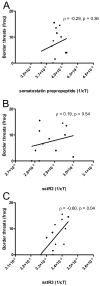Somatostatin and somatostatin receptor gene expression in dominant and subordinate males of an African cichlid fish
- PMID: 17374406
- PMCID: PMC2696992
- DOI: 10.1016/j.bbr.2007.02.014
Somatostatin and somatostatin receptor gene expression in dominant and subordinate males of an African cichlid fish
Abstract
Somatostatin is a neuropeptide best known for its inhibitory effects on growth hormone secretion and has recently been implicated in the control of social behavior. Several somatostatin receptor subtypes have been identified in vertebrates, but the functional basis for this diversity is still unclear. Here we investigate the expression levels of the somatostatin prepropeptide and two of its receptors, sstR2, and sstR3, in the brains of socially dominant and subordinate Astatotilapia burtoni males using real-time PCR. Dominant males had higher somatostatin prepropeptide and sstR3 expression in hypothalamus compared to subordinate males. Hypothalamic sstR2 expression did not differ. There were no differences in gene expression in the telencephalon. We also observed an interesting difference between dominants and subordinates in the relationship between hypothalamic sstR2 expression and body size. As would be predicted based on the inhibitory effects of somatostatin on somatic growth, sstR2 expression was negatively correlated with body size in dominant males. In contrast sstR2 expression was positively correlated with body size in subordinate males. These results suggest that in A. burtoni social status affects the relationships between somatostatin prepropeptide and receptor gene expression in the hypothalamus and the control of somatic growth.
Figures




References
-
- Brazeau P, Vale W, Burgus R, Ling N, Butcher M, Rivier J, Guillemin R. Hypothalamic polypeptide that inhibits the secretion of immunoreactive pituitary growth hormone. Science. 1973;179:77–79. - PubMed
-
- Patel YC. Somatostatin and its receptor family. Frontiers in Neuroendocrinology. 1999;20:157–198. - PubMed
-
- Nelson LE, Sheridan MA. Regulation of somatostatins and their receptors in fish. Gen Comp Endocrinol. 2005;142:117–133. - PubMed
-
- Weckbecker G, Lewis I, Albert R, Schmid HA, Hoyer D, Bruns C. Opportunities in somatostatin research: biological, chemical and therapeutic aspects. Nat Reviews Drug Discovery. 2003;2:999–1017. - PubMed
-
- Epelbaum J, Dournaud P, Fodor M, Viollet C. The neurobiology of somatostatin. Critical Rev Neurobiol. 1994;8:25–44. - PubMed
Publication types
MeSH terms
Substances
Grants and funding
LinkOut - more resources
Full Text Sources
Research Materials

